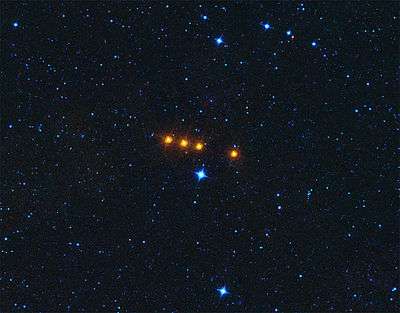31 Euphrosyne
|
Three-dimensional model of 31 Euphrosyne created based on light-curve. | |
| Discovery | |
|---|---|
| Discovered by | J. Ferguson |
| Discovery date | September 1, 1854 |
| Designations | |
| Pronunciation | /juːˈfrɒzᵻniː/ ew-FROZ-i-nee |
Named after | Euphrosyne |
| A907 GP; A918 GB | |
| Main belt | |
| Orbital characteristics[1] | |
| Epoch December 31, 2006 (JD 2454100.5) | |
| Aphelion |
3.861 AU (577.571 Gm) |
| Perihelion |
2.438 AU (364.755 Gm) |
|
3.150 AU (471.163 Gm) | |
| Eccentricity | 0.226 |
|
5.59 yr (2041.585 d) | |
Average orbital speed | 16.57 km/s |
| 14.500° | |
| Inclination | 26.316° |
| 31.238° | |
| 61.996° | |
| Physical characteristics | |
| Dimensions | 255.9 ± 5.8 km IRAS[1] |
| Mass | (58.1±19.7)×1018 kg[2] |
Mean density | 6.61±2.41 g/cm³[2] |
| 0.2305 d (5.531 h)[1] | |
| Albedo | 0.0543 [3] |
| Temperature | ~159 K |
Spectral type | C[1][4] |
| 10.16[5] to 13.61 | |
| 6.74[1] | |
|
| |
31 Euphrosyne is the 12th-largest and the 5th-most-massive asteroid in the asteroid belt, discovered by James Ferguson on September 1, 1854. It was the first asteroid found from North America. It is named after Euphrosyne, one of the Charites in Greek mythology.
It is a fairly dark body near the belt's outer edge. Consequently, Euphrosyne is never visible with binoculars, having a maximum magnitude at the best possible opposition of around +10.2, as in November 2011, which is actually fainter than any of the thirty asteroids previously discovered.[6]
It is a very little-studied body despite being one of the largest asteroids. It is a C-type asteroid with a primitive surface. Its orbit, however, is quite unusual and bears a considerable resemblance to that of 2 Pallas in its high inclination and eccentricity. Whereas Pallas and Eris—the only larger bodies with comparably tilted orbits—have nodes near perihelion and aphelion, Euphrosyne's perihelion lies at the northernmost point of its orbit. During a rare perihelic opposition Euphrosyne is very high in the sky from northern latitudes, but invisible from such countries as New Zealand and Chile.
The mass estimate of Euphrosyne in Baer (2011) makes it apparently the 5th-most-massive asteroid, coming after only the "big four". It also has the highest estimated density, indicating that it is a solid body like the other largest asteroids. However, all large asteroids with comparable densities (16 Psyche and 532 Herculina) have very large uncertainties, so both the mass and density are likely to be lower than the median estimate.
Its rotation period is typical for large asteroids. Nothing is known of its axial tilt.
Euphrosyne has been studied by radar.[7]
This object is the namesake of a family of 323–2066 asteroids that share similar spectral properties and orbital elements; hence they may have arisen from the same collisional event. All members have a relatively high orbital inclination.[8]

References
- 1 2 3 4 5 "JPL Small-Body Database Browser: 31 Euphrosyne" (2008-05-01 last obs). Retrieved 2008-05-23.
- 1 2 Jim Baer (2010). "Recent Asteroid Mass Determinations". Personal Website. Retrieved 2011-09-03.
- ↑ http://www.psi.edu/pds/asteroid/EAR_A_5_DDR_ALBEDOS_V1_1/data/albedos.tab
- ↑ Astrometric and Geodetic Properties of Earth and the Solar System
- ↑ "Bright Minor Planets 2000". Minor Planet Center. Retrieved 2008-05-23.
- ↑ Brightest asteroids
- ↑ "Radar-Detected Asteroids and Comets". NASA/JPL Asteroid Radar Research. Retrieved 2011-10-30.
- ↑ Novaković, Bojan; et al. (November 2011), "Families among high-inclination asteroids", Icarus, 216 (1), pp. 69–81, arXiv:1108.3740
 , Bibcode:2011Icar..216...69N, doi:10.1016/j.icarus.2011.08.016.
, Bibcode:2011Icar..216...69N, doi:10.1016/j.icarus.2011.08.016.
